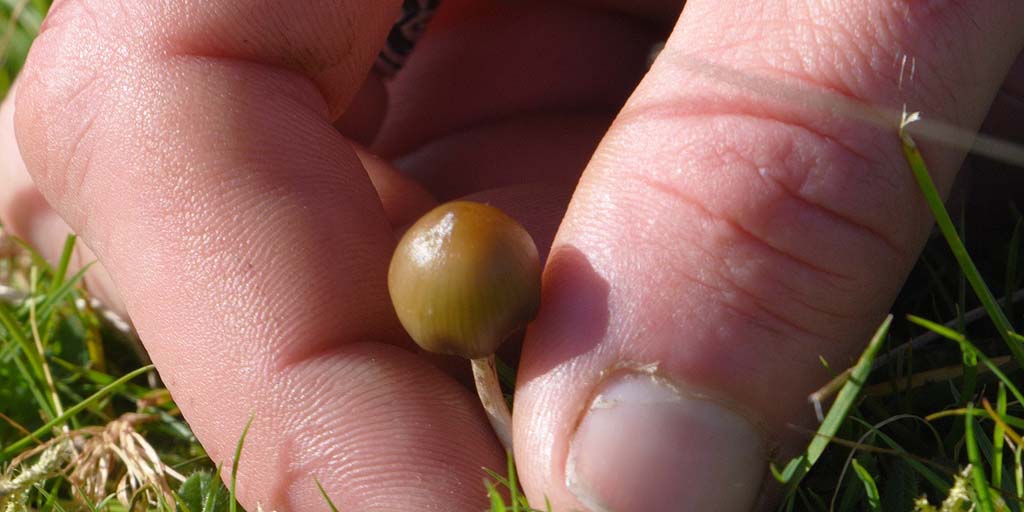
Looking for mushrooms in the wild is both cool and risky. But definitely possible if you know what to be careful of. In this article we dive into the complex world of mushroom identification. And then of very specific mushrooms that you can find in Western Europe: the liberty cap. This is an edible mushroom with psilocybin, which is quite strong. Where can you find them and how can you recognize and prepare these mushrooms to experience a mind-blowing trip without spending a dime? By the way, we won't do that without telling you that this activity can be life-threatening if you don't know what you're talking about.
Warning: Wild Picking Can Be Dangerous
Dutch Headshop takes no responsibility for the misidentification of mushrooms and its possible consequences. Every year, enthusiastic wild mushroom pickers make the news. Often when the deadly poisonous death cap is mistaken for a tasty mushroom that closely resembles it. Oops. While not every "poisonous" mushroom has to end up with an instant tombstone if you eat it, there are many unpleasant effects that many mushrooms can bring about. From dizziness, nausea, stomach cramps and vomiting to cardiac arrhythmias and even permanent liver damage. Please don't become just a statistic. Make sure you know what you are doing when you pick mushrooms. At the end of this article we put down our recommendations for mushroom picking.
Searching Psychedelic Mushrooms in Western Europe
Western Europe is home to quite a few psychedelic mushrooms. We introduce you to three mushrooms that you can just find in nature and actually also belong in the smartshop.
Fly Agaric (Amanita muscaria)
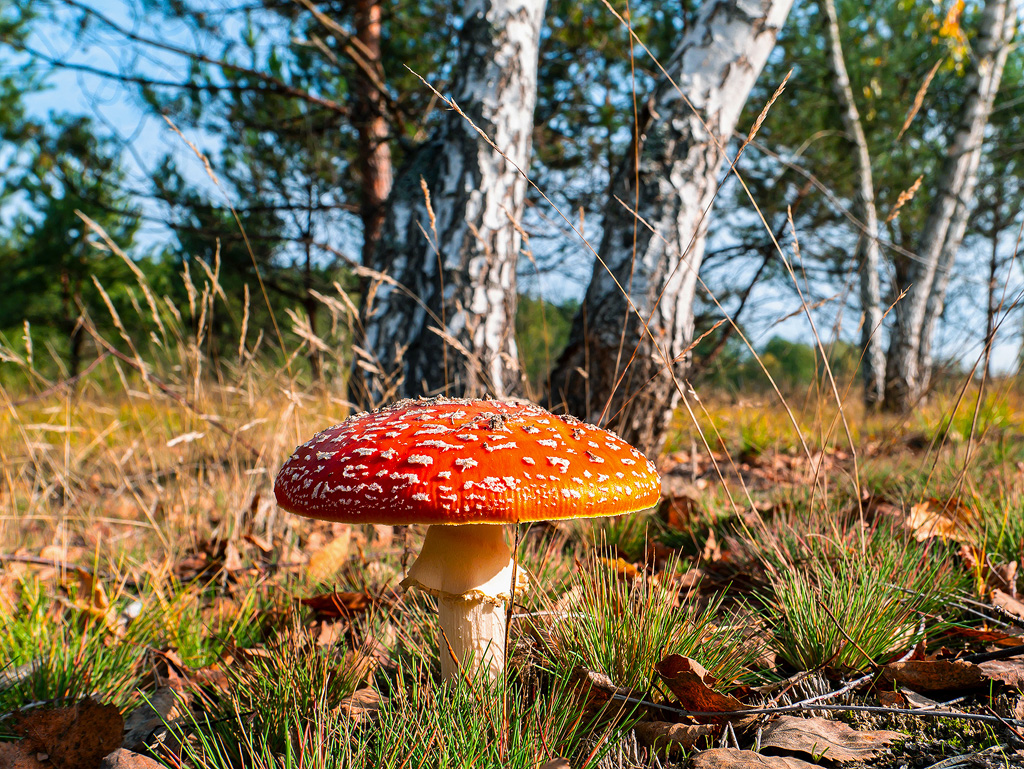
Perhaps the most well-known and recognizable is the fly agaric. With a bright red to pale orange color and white speckles, the Amanita muscaria has captured many a child's heart due to its presence in fairy tales and cartoons. The fly agaric is truly pictured everywhere once the days get shorter and cold weather lurks in autumn. It is the mushroom you probably think of when you hear the word mushroom. An interesting thing to dive into is that the fly agaric may well be the reason Santa Claus is depicted in red and white, but that is beyond the scope of this article.
Toxic, but not lethal?
The fly agaric may not be as lethal as previously believed. That misconception arose in 1897 when an Italian diplomat died in America from misidentifying the fly agaric. Although he had some health problems, the diplomat is known to have eaten plates full of mixed mushrooms with a friend one evening that they had purchased at the market. His friend escaped death, but the poor diplomat was not so lucky. It could be that besides the fly agaric, highly poisonous mushrooms were also eaten, such as the panther cap or death cap. Those guys contain so-called amatoxins that affect your liver. The fly agaric does not contain these substances. However, that does not mean that the fly agaric is not poisonous. With proper preparation, the fly agaric loses its toxicity. In Japan, for example, they are eaten as a delicacy.
The fly agaric is not similar to the well-known magic mushrooms. The most famous mushroom on earth does not contain psilocybin or similar substances. Instead, you find muscimol and ibotenic acid in the red mushroom with white dots. Together, those substances produce an unpleasant and confusing intoxication full of pain in your stomach. You don't see beautiful colors as you do with magic mushrooms, but you lose your mind for several hours, which means you might as well be hallucinating. You get a lot of energy and at the same time you get completely drained of your energy. How is that possible? Because muscimol makes you calm (GABA agonist) and ibotenic acid excites you (glutamate agonist). Want to know more about the effects of the fly agaric? Check out the beautifully made video below:
Habitat
The fly agaric is common in forest hedgerows, moors and even mixed woodlands. They often share the same habitat with bracken ferns as well as birch, oak, sweet chestnut and beech and to a minor degree pine and spruce.
Season
From late August through December.
Recognizing
- Hat: 5-20 centimeters wide.
- Stem: 5-20 centimeters long, 1-2 centimeters wide.
- Colors: red, orange or white (rarely) hat with white dots. White stem, spurs. flesh (what the hat is made of, without the red skin) and also white plates (or lamellae on the underside of the hat).
- Odor: mildly earthy, none.
- Composition psychoactive substances (fresh fly agaric):
- Psilocybin: 0%
- Muscimol: about 0.046%
- Ibotenic acid: about 0.0008%
- Composition of psychoactive substances (3 days drying in the sun):
- Muscimol: about 0.022%
- Ibotenic acid: about 0.0096%
- Advanced:
- Platelets (lamellae) on free hymenium
- Hat is flat or convex
- Stem has ring and volva
- White spore print
Liberty cap (psilocybe semilanceata)
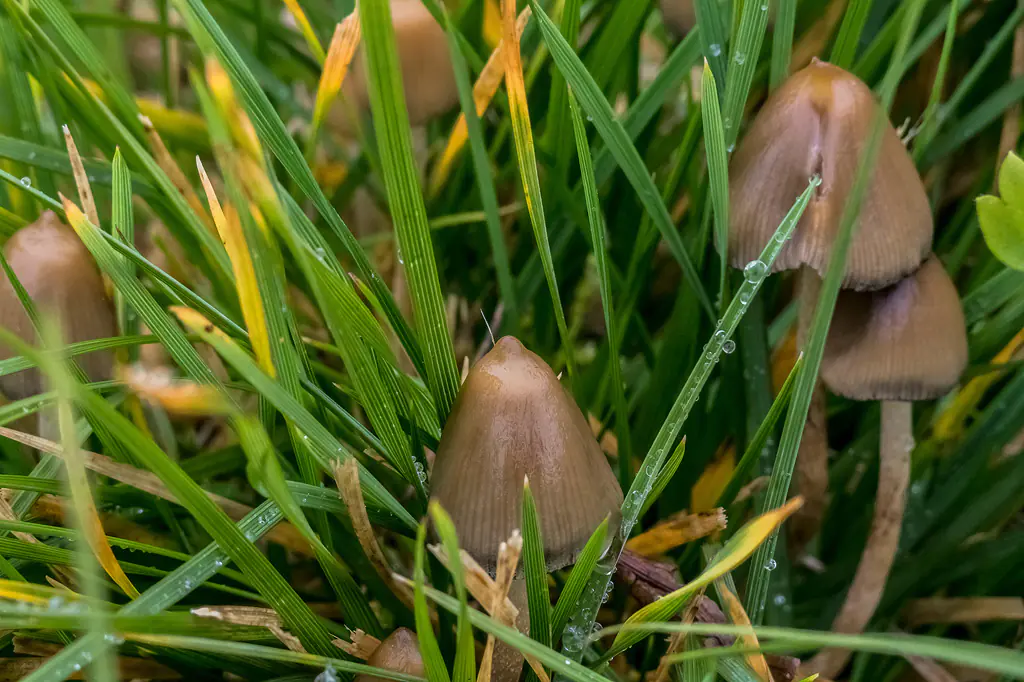
The liberty cap has several names. Internationally, they are known as liberty caps. These small brown mushrooms are both one of the most widely distributed mushrooms containing psilocybin and one of the most potent. In northwestern Europe, the mushroom has a long history of traditional use. It is likely that the Vikings used this mushroom to get in touch with Odin and other gods.
Although we know the vikings took magic mushrooms, we don't know exactly which ones. They were very good at many things, but writing down their daily activities was not their strong suit. Reasonably, we can assume it was the liberty cap because this species is common. Also in Denmark and the Norwegian fjords. Even in Iceland you can find them. With the collapse of Viking society in the late Middle Ages, the tradition also stopped. But back then people didn't know what made magic mushrooms induce those visions. The most recent, reliable source of intoxication by this particular mushroom dates back to 1799. In the 1960s, it was confirmed that the liberty cap does indeed contain psilocybin.
The liberty cap is the main species of the genus psilocybe.
Habitat
Liberty caps can be found all over the northern hemisphere, especially in Europe. They grow on grass by feeding on decaying grass roots, especially in wet areas and on sandy soil. Unlike the well-known and easy to grow psilocybe cubensis, they do not grow on cow manure.
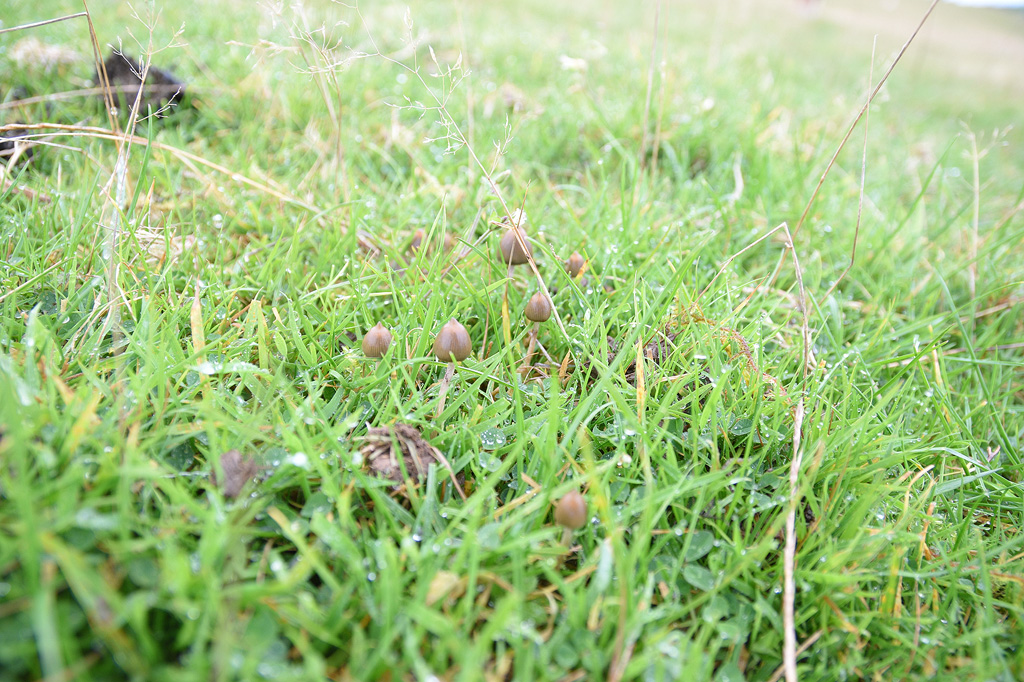
Season
From August to October, exceptionally also to January.
Recognizing the liberty cap
- Hat: 0.5-2.5 centimeters wide. Pointed cone-, bell- or cap-shaped with a "nipple" on top, curving inward.
- Stalk: up to 15 centimeters long, 1-3.5 mm wide.
- Colors: light yellow to light brown cap, stalk light yellow to dark brown. Often the same color as the cap. The lamellae are light brown at first, but purple brown as the spores mature.
- Odor: mildly earthy, none.
- Composition of psychoactive compounds:
- Psilocybin: 0.2 to 2.37%. Average 0.98%.
- Psilocin: 0.01 to 0.02%.
- Baeocystine: 0.36%
- Advanced:
- Platelets (lamellae) attached to the hymenium
- Hat is conical or umbonate (with a hump on top)
- Barren stalk
- Purple-brown spore print
Wavy cap (psilocybe cyanescens)
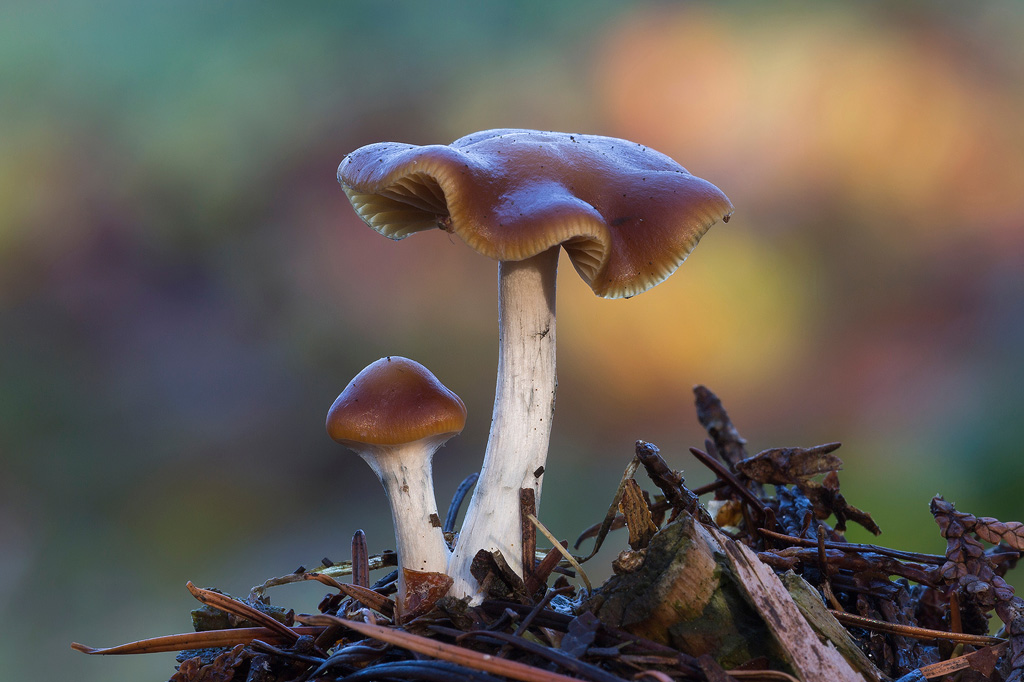
The fact that psilocybe mushrooms turn blue by bruising the stem and/or cap was discovered by mycologist (fungus expert) Paul Stamets. Paul Stamets. It actually indicates in the genus psilocybe the presence of psilocybin because some chemical reactions in magic mushrooms turns them blue. However, it is then no longer psilocybin. For that reason, a blue color is not an indication of how strong a magic mushroom is. Cyanescens means something like blue, and partly because the wavy cap turns so strong when bruised, these mushrooms got this name. Not to be confused with Panaeolus cyanescens, which you can grow yourself with a grow kit.
They contain about as much psilocybin as the liberty cap, but more psilocin which is already hallucinogenic without conversion in our bodies. This is why these mushrooms seem to hit you harder initially.
Habitat
Blue-fading wavy caps can be found in parks and gardens. Like the closely related psilocybe azurescens, they like woodchips. Therefore, they can also be found on landscaped woodchip paths in forests where it is moist enough. Possibly they originated in America and were planted in Europe, but that has not been confirmed. In any case, they are doing well in Europe and can be found more and more often.
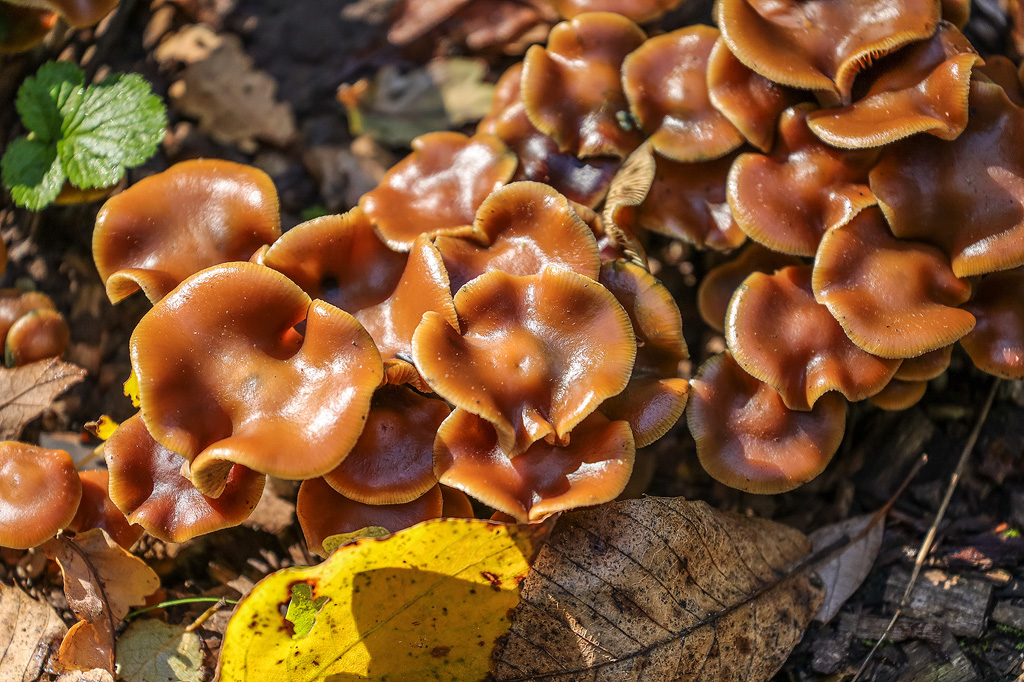
Season
From September to December.
Recognizing the blue-fading wavy capes
- Hat: 2-6 cm wide. Spreads rapidly and mature specimens develop a wavy edge. Sticky.
- Stalk: up to 10 centimeters long, 0.25 to 0.8 cm wide.
- Colors: white and fibrous stalk, often already blue at the base. Red-brown to ochre yellow.
- Smell: bakery flour, fresh green beans.
- Composition of psychoactive substances:
- Psilocybin: 0.3 to 1.68%. Average 0.85%.
- Psilocin: 0.28% to 0.51%. Average 0.36%.
- Baeocystine: 0.02 to 0.03%
- Advanced:
- Platelets (lamellae) attached to the hymenium
- Hat is umbonate (with a bump on top)
- Barren stalk
- Purple-brown to black spore print
Psilocybe Genus Mushrooms
The genus psilocybe has 650 varieties according to Index Fungorum; a large database on the kingdom of fungi. Of these, we identify about 360 species. Most species beginning with psilocybe do indeed contain the psychedelic substances psilocybin, psilocin and/or baeocystin, but not all of them.
Taxonomy
Taxonomy means how biological species are classified according to characteristics they pass on through evolution by natural selection. Quite a mouthful to say that species with similar names are actually related. Since 2010, the naming and classification of the genus psilocybe has been better agreed upon. At that time, an international committee decided that only blue-colored mushrooms could still be named psilocybe. The rest were classified differently.
This is important to point out, because if you have a booklet written before 2010, the Latin names of the mushrooms may therefore be different.
Determination
When searching for mushrooms it is important to know which species you are dealing with. That starts with looking in the right season. The mushrooms discussed above do not appear much, if at all, in spring. However, there are plenty of mushrooms that show up in spring and some of them are also small and brown, just like most mushrooms. Therefore, you can be quite mistaken if you think you find a mushroom in spring that actually only grows in fall. The same goes for habitat. A liberty cap does not grow on dead wood.
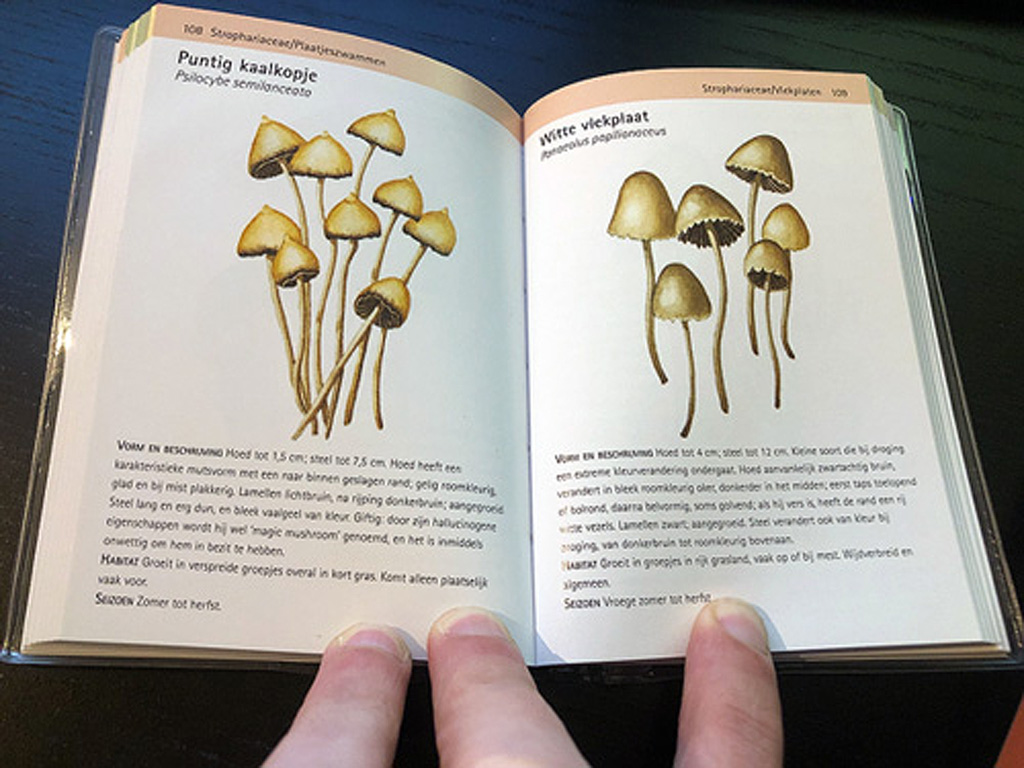
A booklet to take with you in the field is handy. Preferably even two. The more info and pictures the better [1].
Some characteristics are fairly simple, such as the color or shape of the hat. But to really judge properly, you have to take it a step further. Or actually a step lower. Look at the stem. Does the stem have a "skirt"? Or a "sock" just above the ground? Does the bottom of the cap have all these little holes, is it made up of lamellae (plates) or are there spines hanging from it? Also compare the size and smell with what is written in your mushroom booklet. And very important as a final step: never eat wild mushrooms without first making a spore print of them.
Making a spore print
A spore print is the fingerprint of a mushroom. It is an important characteristic that reveals something invisible about the identity of your wild mushrooms. Here's how to proceed. Choose a fresh cap that is already well open. These are mature enough to spread spores. Cut the stem short below the hat so the hat can lie flat on a sheet of paper. Place the hat on a sheet of white paper for 12-24 hours. When you carefully remove the hat afterwards, so many spores will have fallen from the hat that you will see a dusty fingerprint where the hat has been. Compare that spore print as best you can with what you can find online or what is described in your booklet. And if you really want to get it right, also look at the spores under a microscope. Then you can compare the size and shape.
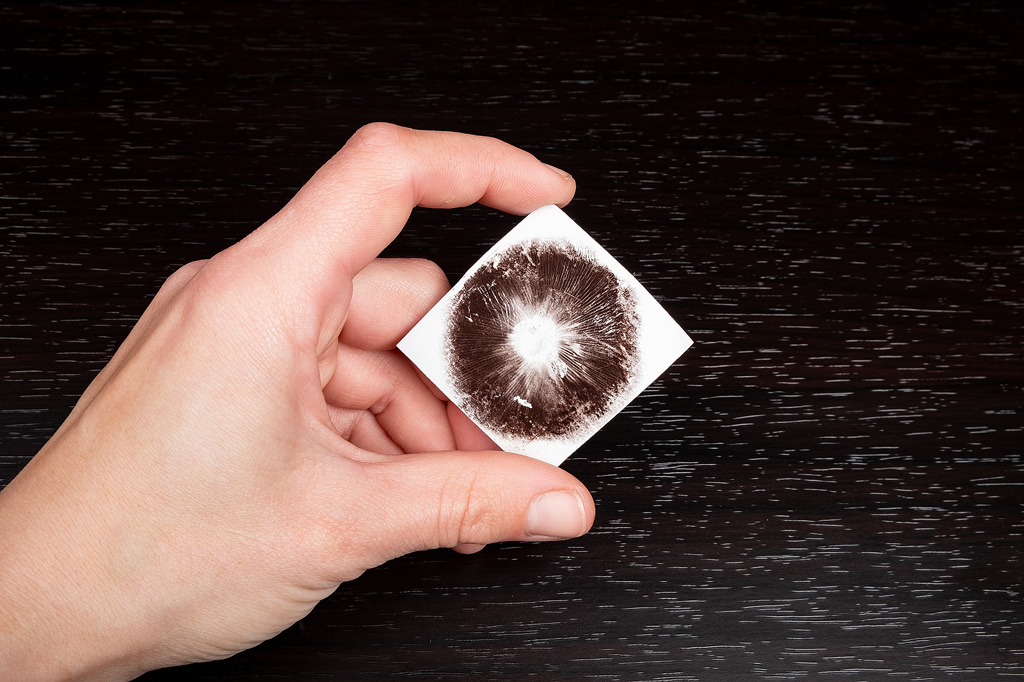
Spore print of a Psilocybe cubensis.
Mushrooms Recognition: Steps
You've read earlier that recognizing mushrooms can be of vital importance. You just have to be 100% sure of the exact species. As a quick guide, below we list the steps you need to go through to help you be more certain.
- Mycologist - Ideally, you should go out with a licensed mycologist (professional fungal expert). Such a specialized field biologist can teach you much more than you read here or anywhere else.
- Booklets - Take a good booklet with you when you go wild picking (preferably two different ones). These are packed with pictures and clear descriptions.
- Season - What season are you picking in? Does that match the description of the mushrooms you are looking for? For example, a liberty cap is rarely if ever found in spring.
- Habitat - If you are looking in a forest for the liberty cap, you are in the wrong area. Make sure you know where the mushrooms can be found.
- Relatives - Learn about the mushrooms that are similar to the one you are looking for. Suppose you do pick the wrong one; is it tasty, harmless or life-threatening?
- Determine - With the tips in this article, you can learn how to determine; or recognize and correctly identify mushrooms. Compare stem, cap, smell; and so on to rule out relatives so you can be more and more certain it is the mushroom you are looking for.
- Spore print - Compare the spore print of the mushroom you picked to something you are sure is correct.
- Community - Make use of websites such as shroomery.org, where not only you but also other mushroom aficionados can report what they found. If several say it's a different mushroom after all, you should update your conclusion: probably not a liberty cap after all!
Mushroom Picking Dangerous? Deadly Species
When you go mushroom picking, you can sometimes come across species that are very similar in appearance to magic mushrooms that will make you trip wonderfully. Some of these species can make you so seriously ill in a short time that it may lead to your death. Earlier we talked about the green tuberamanite and pantheramanite, but they do not resemble the brown psilocybe mushrooms:
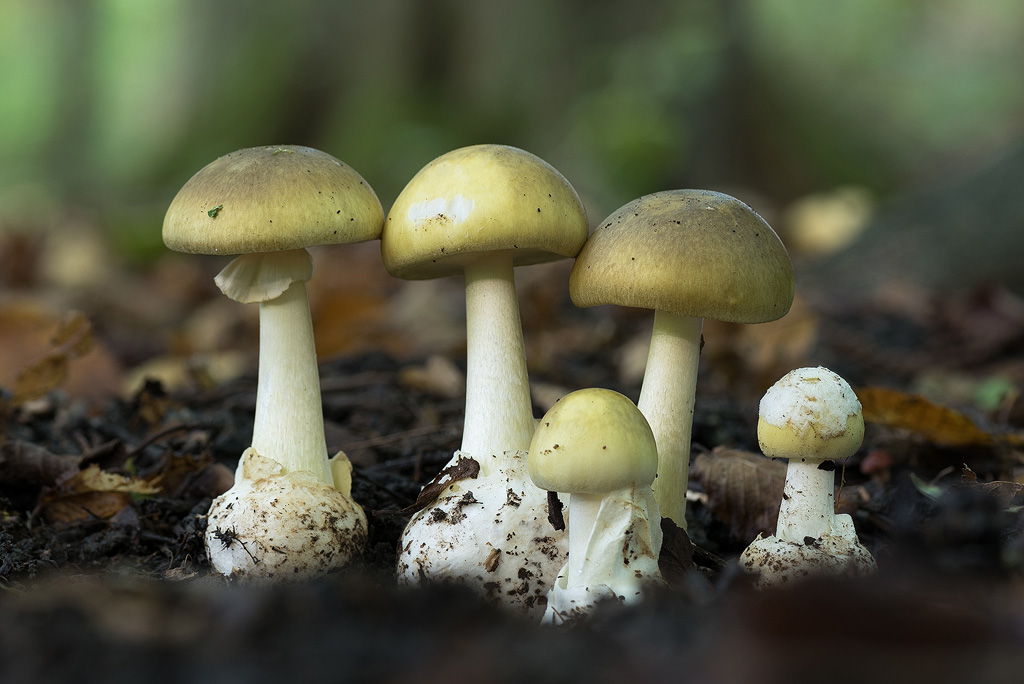
The infamous death cap (Amanita phalloides); one of the world's most lethal mushrooms.
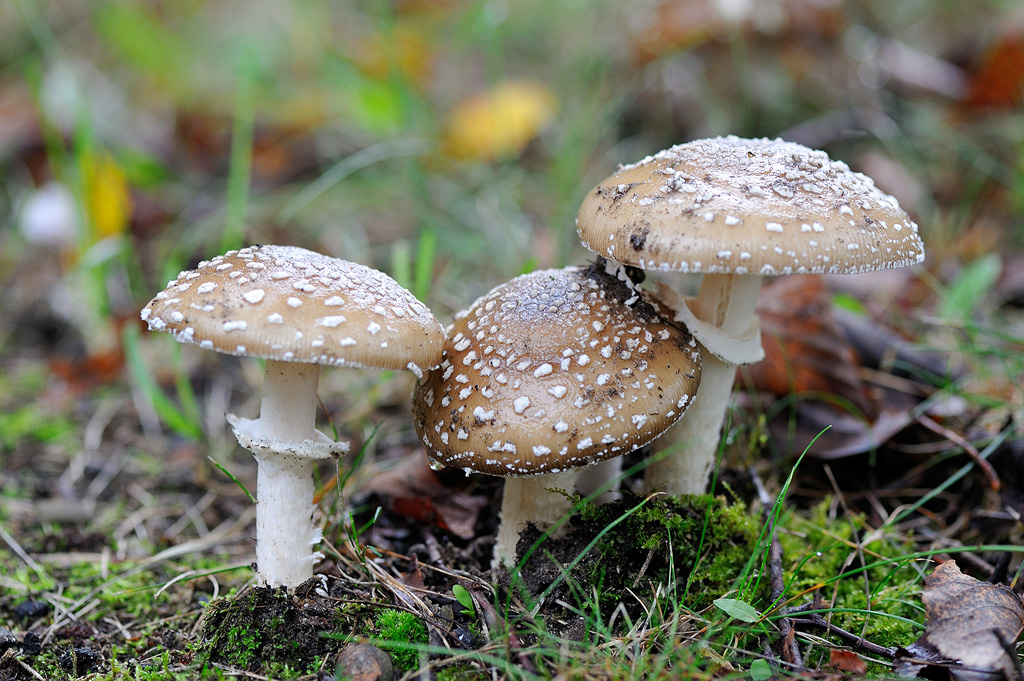
The panther cap (Amanita pantherina) is also among the most deadly, while it resembles the misunderstood fly agaric.
The units below do look like shrooms that contain psilocybin. But they contain the same dangerous amatoxins as the death cap and panther cap, which, among other things, cause fatty liver disease and necrosis.
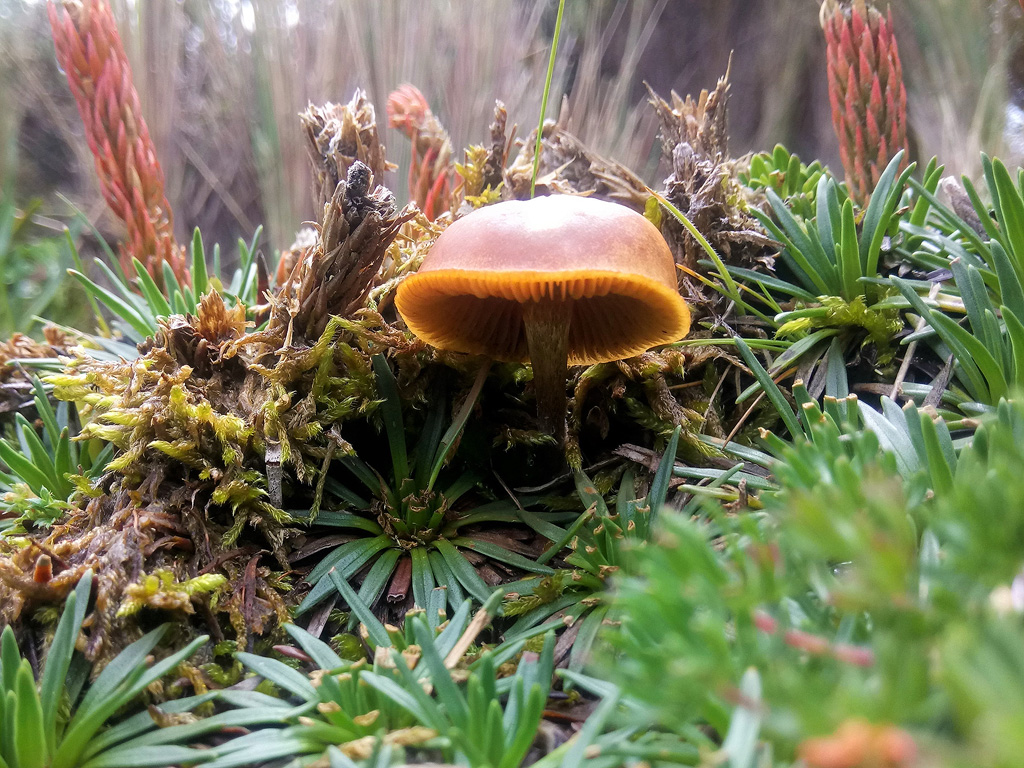
Pholiotina filaris, also known as Pholiotina rugosa or Conocybe filaris. Lethally toxic.
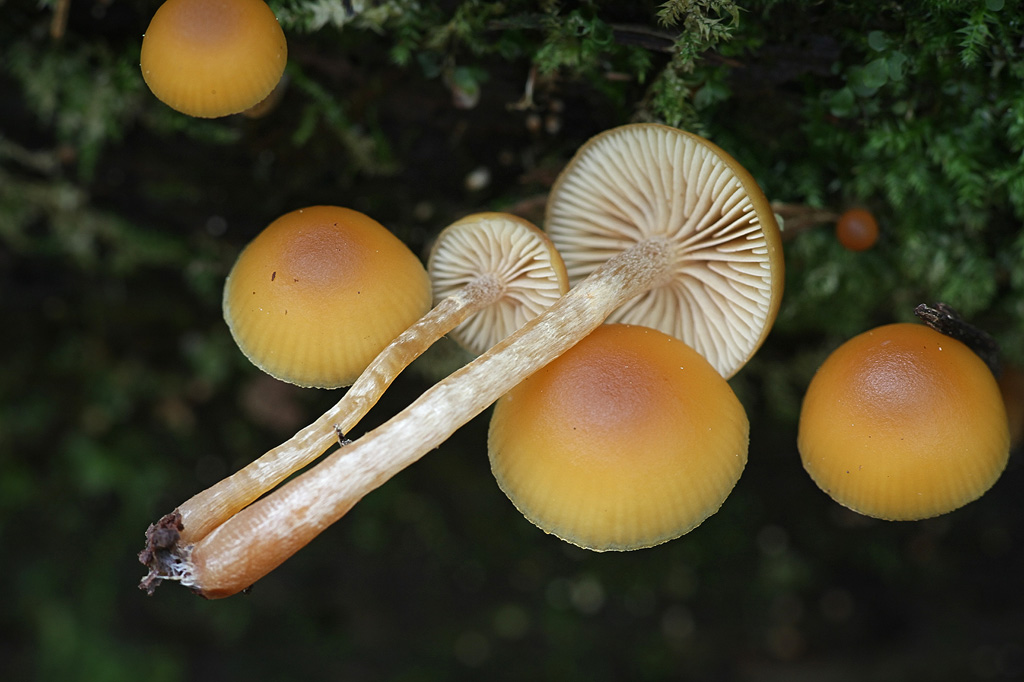
Galerina autumnalis or Galerina marginata. Lethally toxic.
Both mushrooms produce rust-brown spores. Therefore, if these are not purple-brown to black, you are not dealing with fun mushrooms, but with life-threatening mushrooms.
Wild Picking Other Mushrooms
We have covered only 3 magic mushrooms. But there are hundreds of known psychedelic mushrooms. This chart from Paul Stamets' book "Psilocybin Mushrooms of the World" [3] shows a nice indication of the relative strength of common mushrooms with psilocybin, psilocin and baeocystin as active ingredients:
| Species | Psilocybin% | Psilocin% | Baeocystin% | Reference% |
|---|---|---|---|---|
| P. azurescens | 1.78 | .38 | .35 | Stamets & Gartz 1995 |
| P. bohemica | 1.34 | .11 | .02 | Gartz & Muller 1989, Gartz 1994 |
| P. semilanceata | .98 | .02 | .36 | Gartz 1994 |
| P. baeocystis | .85 | .59 | .10 | Repke et al. 1997, Beug & Bigwood 1982(b) |
| P. cyanescens | .85 | .36 | .03 | Stijve & Kuyper 1985, Repke et al. 1977 |
| P. tampanensis | .68 | .32 | n.a. | Gartz 1994 |
| P. cubensis | .63 | .60 | .025 | Gartz 1994, Stijve & de Meijer 1993 |
| P. weilii | .61 | .27 | .05 | |
| P. hoogshagenii | .60 | .10 | n.a. | Heim & Hofmann 1958 |
| P. stuntzii | .36 | .12 | .02 | Beug & Bigwood 1982 (b), Repke et al. 1977 |
| P. cyanofibrillosa | .21 | .04 | n.a. | Stamets et al. 1980 |
| P. liniformans | .16 | n.d. | .005 | Stijve & Kuyper 1985 |
* n.d.: less than the minimum value to measure.
* n.a.: not measured.
For the chart above, you should know that averages have been used and that one batch of mushrooms can be much stronger than another. Sometimes up to 10 times stronger! So to say that one strain is stronger than another is a bit harsh. Also, at the time (1996), baeocystine had not yet been determined to be indeed also strongly psychedelic. It has since been determined. Just like other substances you have never heard of, but which can be found in magic mushrooms, such as norpsilocin, 4-AcO-NMT, psilacetin, aeruginascin and 4-AcO-TMT. The effects are slightly different [4].
Back to searching for mushrooms. The very same Paul Stamets in his book also writes a nice concluding rule of thumb for this article, which he himself says you have to take with a grain of salt:
If a lamellar mushroom has purple-brown to black spores AND it turns blue when you bruise it, then you most likely have a mushroom that produces psilocybin.
Stamets has no exceptions to this rule, but that doesn't mean there aren't any. Moreover, you also don't know what else this mushroom produces besides psilocybin. Make sure you know what you're doing!
Sources:
- [1] “Compactgids Paddenstoelen”. Kosmos Uitgevers. ISBN: 9789021578996. Druk 1. 2021.
- [2] Gerhardt, E. “De grote paddenstoelengids voor onderweg” Kosmos Uitgevers. ISBN: 9789043925662. Druk 17. 2022.
- [3] Stamets, P. “Psilocybin Mushrooms of the World” Ten Speed Press, Berkeley. ISBN: 978089815839-7. Druk 1. 1996.
- [4] Glatfelter, G.C. et al. “Structure–Activity Relationships for Psilocybin, Baeocystin, Aeruginascin, and Related Analogues to Produce Pharmacological Effects in Mice” American Chemical Society. 2 nov. 2022. DOI: 2c00177
- Index Fungorum
- Shroomery.org
- paddenstoelenwerkgroepdrent.com
- Interactieve Paddenstoelengids Naturalis